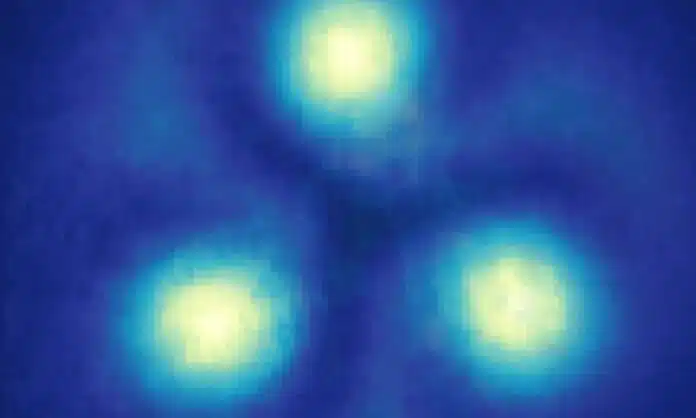
By Amit Malewar 8 Nov, 2024
Collected at: https://www.techexplorist.com/missing-hallmarkf-superfluidity-demonstrated/92047/
Physicists predicted over 50 years ago that quantum mechanics allows for a state of matter that behaves like a solid and a superfluid simultaneously. In this state, a collection of indistinguishable particles can exhibit seemingly contradictory properties simultaneously.
While the crystalline structure that gives supersolids their “solid” nature has been directly observed, their superfluid properties are more challenging to detect. Despite studying aspects of superfluid behavior like phase coherence and gapless Goldstone modes, direct evidence of key superfluid characteristics, such as quantized vortices, has yet to be discovered.
In a significant breakthrough, a team led by Innsbruck physicist Francesca Ferlaino has observed quantized vortices in a rotating two-dimensional supersolid, providing the long-awaited confirmation of superfluid flow within a supersolid. This marks a critical advancement in the study of modulated quantum matter. By combining theoretical models with advanced experiments, the team successfully created and detected vortices in dipolar supersolids, confirming one of the defining features of superfluidity.
In 2021, scientists achieved a breakthrough by creating the first long-lived two-dimensional supersolid in an ultracold gas of erbium atoms, which was a difficult task. Next, they wanted to develop a way to stir the supersolid without destroying its fragile state—required even greater precision” explains lead author Eva Casotti.
Using high-precision techniques informed by theoretical models, the researchers carefully applied magnetic fields to rotate the supersolid. Unlike liquids, which rotate rigidly, this rotation led to the formation of quantized vortices—the hydrodynamic signature of superfluidity. This breakthrough marks a significant step forward in understanding the unique behavior of supersolids and their potential applications in quantum matter research.
The experiment, which took nearly a year to complete, revealed significant differences in the dynamics of vortices between supersolids and unmodulated quantum fluids. This offered new insights into how the superfluid and solid characteristics coexist and interact within these exotic quantum states, deepening our understanding of the complex behavior of supersolids.
Thomas Bland, who guided the project’s theoretical development, said, “Our findings open the door to studying the hydrodynamic properties of exotic quantum systems with multiple broken symmetries, such as quantum crystals and even neutron stars. For instance, it is assumed that the change in rotational speed observed in neutron stars—so-called glitches—are caused by superfluid vortices trapped inside neutron stars.”
“Our platform offers the opportunity to simulate such phenomena here on Earth.” Superfluid vortices are also believed to exist in superconductors, which can conduct electricity without loss.”
Francesca Ferlaino from the Department of Experimental Physics at the University of Innsbruck said, “The next step—developing a way to stir the supersolid without destroying its fragile state—required even greater precision.”
Using high-precision techniques guided by theory, the researchers employed magnetic fields to carefully rotate the supersolid. Because liquids do not rotate rigidly, this stirring caused the formation of quantized vortices, which are the hydrodynamic fingerprints of superfluidity.
This work is a significant step forward in understanding the unique behavior of supersolids and their potential applications in quantum matter.
Journal Reference:
- va Casotti, Elena Poli, Lauritz Klaus, Andrea Litvinov, Clemens Ulm, Claudia Politi, Manfred J. Mark, Thomas Bland, Francesca Ferlaino. Observation of vortices in a dipolar supersolid. Nature, 2024; DOI: 10.1038/s41586-024-08149-7

Leave a Reply